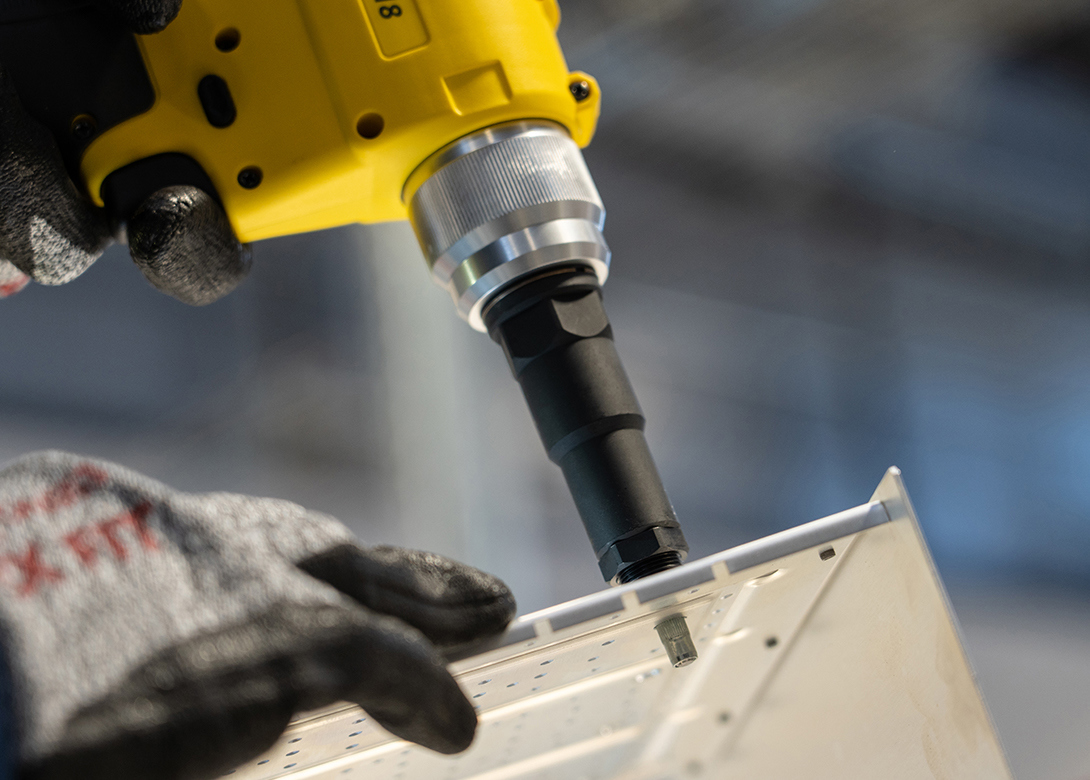
The manufacturing industry is undergoing a rapid shift as it responds to innovations and growth in the solar, wind, and ground transportation markets. Simultaneously, STANLEY is releasing a new generation of battery operated, motor driven hand tools that are comparable to the pneumatic tools traditionally used in manufacturing - especially in engineered fastening applications.
Capable of installing up to 1,100 steel open end fasteners on a single charge, the Stanley PB2500 Smart® is a blind rivet tool with process monitoring designed for manufacturers in the appliances, bus and coach, solar, and white goods sector. It offers a touchscreen display with rivet counts and other live quality data and is ideal for safety critical mountings such as seating and handles.
Engineered to maximise efficiency on rail, bus, and coach production lines is the Stanley SB25PT-05®. The speed rivet system is magazine fed and doesn’t produce any waste material. It is compatible with its pneumatic predecessor tools, allowing easy interchange of components - making the transition to cordless considerably less expensive.
The first cordless blind rivet nut tool in the Stanley Engineered Fastening range, the Stanley NB08PT-18® was designed for bus and rail coach, HVAC systems, and domestic appliance manufacturing operations. It can install 900 steel blind rivet nuts on a single battery charge, features a touch operated screen with live rivet counts, and has programmable stroke and force settings that provide consistent, precise rivet placements.
Cutting costs with cordless tools
Until now, pneumatic tools were the industry standard in manufacturing, with good reason - they deliver consistent power and require little maintenance. But the inefficient pneumatic systems behind them are costly to maintain, monitor, and operate.
Generating compressed air can account for up to 10% of the energy consumption in a production facility, and that doesn’t even begin to address the costs associated with system maintenance and disposal of the oily wastewater by products of compressed air. Cordless electric tools also lower the risk for workplace accidents - both from tripping over hoses and being injured by damaged air lines - reducing company liability and the threat of costly legal settlements.
Improving user experiences
In the manufacturing world, technicians use tools in ways that are radically different from the way consumers do. Rather than sporadic use on a weekend project, professional manufacturing teams use their hand tools for hours on end, repeating the same motions over and over.
Battery operated hand tools offer lighter, quieter operation and improved ergonomics over pneumatic tools, partly due to no longer having to ‘fight’ with air hoses. The lower vibrations produced by cordless tools are less physically taxing to operators, and no hoses means fewer trip hazards and no risk of injury from broken or damaged air lines. While the improvements to operator safety are a step forward in the manufacturing industry, this new generation of cordless tools offers another benefit: enhanced quality control features.
Contributing to a greener future
As we enter an increased awareness around the environmental impacts of fossil fuel use, and it is driving growth along with policy and regulatory change. Environmental regulations are designed to serve the common good, but compliance can be challenging for production facilities that are required to make expensive upgrades. Shifting from air driven tools to cordless, electric models is one of the ways that industry is meeting new efficiency standards.
Answering the call to lower global emissions through increased use of renewables, alternative energy markets are surging. Over the next five years, solar energy has a global CAGR of 20%, and the CAGR of wind energy is just over 10%. When pneumatic tools are used in site-specific installations, like wind or solar energy projects, they require additional labour and equipment to move heavy generators, fuel, and hoses around the site. Battery operated hand tools give technicians the ability to move quickly and easily from one part of the job to the next - only needing a couple extra batteries on hand.

Having spent a decade in the fastener industry experiencing every facet – from steel mills, fastener manufacturers, wholesalers, distributors, as well as machinery builders and plating + coating companies, Claire has developed an in-depth knowledge of all things fasteners.
Alongside visiting numerous companies, exhibitions and conferences around the world, Claire has also interviewed high profile figures – focusing on key topics impacting the sector and making sure readers stay up to date with the latest developments within the industry.
Don't have an account? Sign Up
Signing up to FastFixTechnology.com enables you to manage your account details.